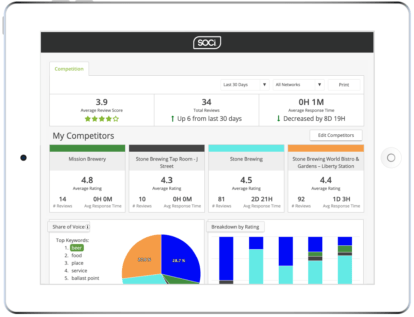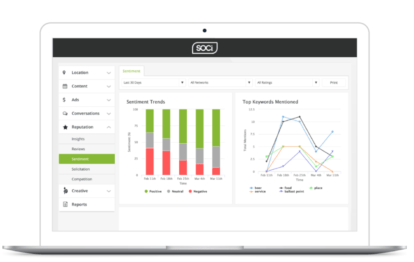In the world of localized social marketing, platforms continue to change and user habits continue to evolve. Still, some things remain static; every digital marketing all digital marketers want to see engagement and every marketer wants to control their online reputation.
However, some engagements matter more than others, and the reputation management space if shifting. Traditional review sites like Yelp continue to receive reviews, but social platforms like Facebook and Google are receiving more reviews than any other reputation platform.
In the ever-evolving social media and reputation management spaces, these details matter. SOCi’s latest research report — State of the Market: The Power of Organic AND Paid Content — features analysis of our platform data, then provides insights into the latest trends marketers need to know in the worlds of social media and reputation management. Below, we highlight five key insights.
1. Where are your customers leaving their reviews?
Reviews have spread beyond the confines of review sites like Yelp and TripAdvisor and into the most popular platforms on the web, including Facebook and Google.
According to the latest State of the Market report, Google My Business (GMB) and Facebook are the top platforms in terms of total volume of reviews, as they were in the Q4 2018 State of the Market report. Other review sites saw an increase in review volume from Q1 to Q4; OpenTable, Yelp, TripAdvisor, and Expedia grew by 3 percent, 4 percent, 7 percent and 9 percent, respectively. The growth in these networks emphasizes the need for multi-location marketers to not only be aware of, but actively managing, any and all review platforms where consumers are engaging.
Stay up to date on social media trends and the latest SOCi news. Sign up today.
2. How much do consumers care about star-ratings?
Consumers have high standards for star-ratings. SOCi data shows that more than 50 percent of consumers won’t consider a business unless it has at least 3.5 stars. As a result, the ratings and review space is a competitive one; if all your competitors have 4 stars and your business only has 3.5, consumers are likely passing up your business in favor of the competition.
The State of the Market report reveals that from Q4, 2018 to Q1 2019, the overall average star rating across top review sites dropped 0.19 points — from 3.98 to 3.79. However, the overall volume of reviews did increase during this time. Marketers are recognizing the importance of a strong star-rating, and despite the drop, brands are still maintaining a score above the minimum expected star rating of 3.5.
Reviews have infiltrated every digital social space, and are highly visible as a result. In response, businesses must develop a strategy to garner a high volume of reviews and respond to all reviews, comments and questions. A smart reputation management strategy also involves monitoring competitors’ reviews and proactively adjusting business practices based on consumer feedback. SOCi can help multi-location marketers consolidate this process through features called Reputation Competition and Reputation Sentiment.
Reputation Competition allows users to analyze competitors’ online reputation at the local level – without any manual research. It empowers users to easily identify areas for opportunity in their local market, see reputation trends across similar brands and discover ways to set themselves apart from the competition.
Reputation Sentiment filters out the noise, provides a clearer picture of common keyword usage, and shows if these terms are used in a positive, negative, or neutral manner over a given timeframe
3. What is the difference between high-value and low-value engagements?
Each social platform has different actions that constitute high-value and low-value engagements. On Facebook, comments, shares and direct messages are high-value engagements and likes and other reactions are considered low-value. On Instagram, comments are the only actions that count as high-value engagements. On Twitter, direct interactions such as mentions, direct messages or replies are high-value engagements and favorites or retweets are seen as low-value.
Social marketers are making a major shift to focusing on high-value engagements instead of low-value engagements. SOCi data shows a 214% increase in high-value engagements from Q4 to Q1. Businesses are creating highly relevant local content — using social media tools and features to engage with consumers in a meaningful way through comments, by responding to mentions or replies, thanking users for shares, or responding to messages directly.
4. The powerful effect of high-value engagements.
An increase in high-value engagements with your local community leads to an increase in reach for your organic posts. Organic reach can be as low as < 1 percent of Page followers, but as high as 10 percent if your posts get high-value engagements from followers.
While 10 percent of your Page followers doesn’t match the reach businesses were seeing prior to Facebook’s 2018 algorithm changes, marketers should make every effort to encourage these high-value engagements on organic content in order to achieve the maximum reach. Part of a diversified localized social marketing strategy involves incorporating localized content that encourages engagement through organic efforts, while leveraging tactics such as Facebook Boost to enhance the reach and engagement of certain key pieces of content.
5. When should I post to achieve maximum engagement?
Although most marketers prefer to post in the window between 9am and 5pm, that approach could be limiting engagement levels. According to the SOCi’s State of the Market report, the highest engagement levels — in terms of shares and comments— are seen at night.
This makes sense when we think about our own digital activity as consumers. Users “catch up” on the day at home; dual-screen after dinner and while winding down before bed. To match user behavior, marketers should consider posting new content at night, in order to capitalize on pre-existing nighttime social habits.
What does this all mean?
As social media engagement takes on a more important role and reviews infiltrate more digital spaces, businesses must respond with an all-encompassing strategy for localized social marketing. How will you boost organic engagement AND develop a paid social approach? How can you respond to reviews on traditional review platforms AND manage your reputation on social media sites? For many multi-location marketers, the answers to these questions are found in a social media and reputation management platform like SOCi.
Download the State of the Market report now to see how SOCi users succeed in social media and reputation management.


